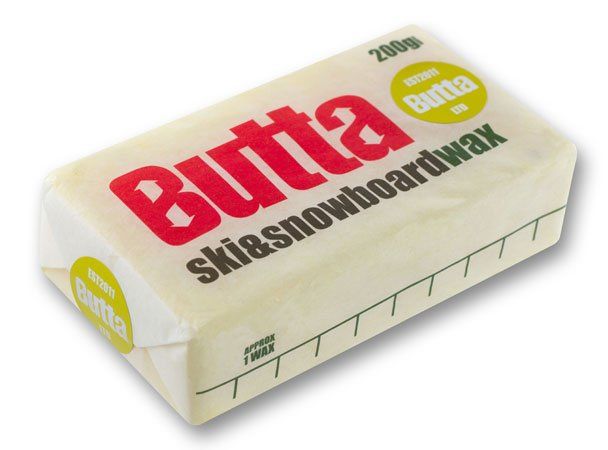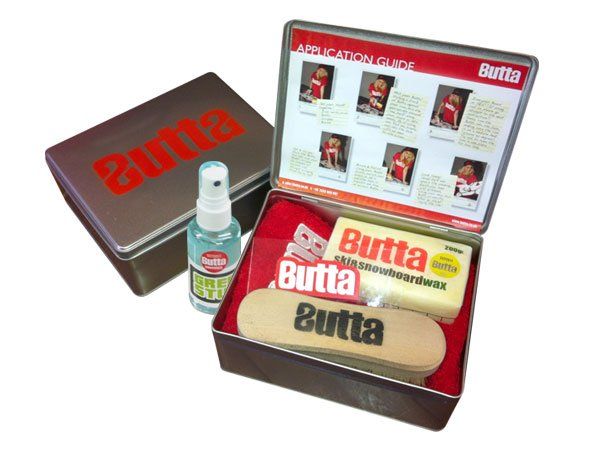Ideally go tip to tail or tail to tip and hold your scraper so the base in contact with the board/ski is closer to you than the top is (hold it at about 60 degrees to the base) and push away from yourself, this stops the scraper catching and gives you better control. This next bit may sound a little counterproductive but your aim is to get as much wax off the base as possible so when you get to the stage that you are not removing any more wax you are done scraping.
BASE PREP & EDGE GUIDE
Please sharpen the edges before starting on the base.
The sections covered are-
- You will need
- You may also want
- Things to think about before you start
- Area prep
- Structure to work on
- Rubbing down the base
- Cleaning the base
- Applying your hot wax
- Applying dry slope waxes
- Applying a rub on wax
- Scraping off
- Structuring
- Edge Sharpening
1. You will need
- Scraper – I find an Acrylic one works best.
- Wax – Butta, DataWax, Beaver, Maplus or Demon are the brands I use.
- Structure Pads – Red and Grey are my choice.
- Acrylic/Nylon bristle brush – an alternative to structure pads.
- Base Cleaner – I use Butta, DataWax or Beaver base cleaners
- Iron – Ski/Board iron is best but any cheap non steam one will work.
- Solid base to work on.
- A face mask if you are using a graphite wax.
2. You may also want
- Good tunes.
- Cold beers 18+ (age not quantity).
- Wearing clothes you don’t mind getting wax on.
3. Things to think about before you start
- Melted wax and waxing irons get hot, I know this is obvious but I have burnt myself with both.
- Ski and Snowboard edges are sharp so watch them. Again, I have had a good few cuts on edges.
- Have a rag or cloth ready to wipe the iron after you have finished and do this when it is still hot as it is loads easier than cleaning a cold one.
- Make sure you can get to both ends with the iron when plugged in.
- Don’t leave your hot iron in one area for too long as this will cause damage and could separate the internal layers.
4. Area prep
Use a big enough area so you can walk around the board/ski and remember that you will be putting lots of wax on the floor, so not on carpet as wax can be messy.
5. Structure to work on
This is your call but remember your job will be a lot harder if your ski or board moves around too much. Keyboard stands can be a great and cheap base to work on.
6. Rubbing down the base
Structure Pads.
Always use a tip to tail motion (either direction) with structure pads and you only need to use the red one pre waxing. As you are rubbing you will feel through the pad if there are any areas of concern that you may need to spend a little time on for example, any gouges or scrapes that have rough edges. Work on these until you are happy that they are fairly smooth and the wax will fill any minor imperfections. If they are major you may need a repair but be aware this type of damage may require an expert. I would suggest a good rule of thumb for base prep is when it feels fairly smooth you are about there.
Acrylic/Nylon Bristle Brush.
When using a brush, it is just a simple rub down tip to tail in either direction, a brush is quick and all that is necessary if your base is new or in good condition.
7. Cleaning the base
Using a base cleaner and a rag, cloth or paper towels and keep going until you cloth is clean, you will also take old wax off and you can tell you are doing this when the base feels a little sticky. A good clean before you start to wax will give you loads of pores to fill with your new hot wax and this is what you want. Make sure the base is free from residue and dry before you start with the hot wax.
8. Applying your hot wax
Right, you have a nice clean base that is gagging for some good deep hot wax action so don’t rush it, switch on your iron and set it to the correct temp for your wax remembering that this does vary. If you have a basic iron without a temp setting I would suggest low to middle so it melts the wax but does not make it smoke. Now start at one end dripping it on from about 4-6 inches and apply a smaller amount of wax than you think as you can add more if needed, start at one end of the base and work your way to the other end, you should only need to be in one place for a short time and just use the weight of the iron. Make sure you get all of the base and pay particular attention to areas that have scratches, try not to get too much over the edge and take this off with your scraper before you start to scrape the base. Now leave it to cool, I usually leave them for at least an hour but overnight is best.
9. Applying dry slope waxes
Applying Butta dry slope wax – Other brand waxes may use a different process
Apply Butta dry wax as above but try to get it as even as possible and DON’T scrape it off as you ride on the wax layer. If you get wax on the metal edge, scrape it off the edge when it is warm as this will be much easier. WAIT AT LEAST TWO HOURS AND THEN GO RIDE/SKI !!
Applying DataWax Polar X & GX dry slope wax – Other brand waxes may use a different process
For maximum effects we recommend that you iron on Polar X/GX (keep the iron moving at all times) and allow to cool but don’t scrape.
Then iron a second time and then scrape while the wax is still warm.
Structuring and glossing don’t massively benefit your base with the DataWax Polar waxes so leave it to cool and then go play.
Applying Maplus Artctic Base wax – Other brand waxes may use a different process
Apply Maplus Arctic Base wax as you would a hot wax (iron temp 150c) and leave 15 minutes to cool. Scrape as normal and then go play.
To give a pro base finish or if you are needing ultimate speed you can use these three brushes in this order – Brass then Horsehair then Nylon.
10. Applying a rub on wax
You apply a rub on wax exactly as you would expect, you just rub it on. This takes a little effort but is ideal if you need a wax job and you can’t get an iron or you have had a hot wax before you went away and just need a little boost near the end of your holiday.
After you have rubbed it on, you will scrape it off in the same way you would with a hot wax but there is less to remove, the following section will explain scraping fully.
11. Scraping off
Structuring
Don’t be tempted to miss this bit out as structuring gives you the glide that everyone wants. Again rubbing tip to tail, start with the red pad and then use that grey one covering the full base with each, alternatively you can use a nylon brush for a quick structure. This adds tiny channels to the base that can’t be seen but allows the snow, water and air to glide under the base without causing suction. If you want to go that next stage you can use a cork block on the base, rubbing tip to tail again and the friction melts the wax into the areas that may have been missed. I would suggest two passes at this, the first one is done with pressure on the base and the second with just the weight of the cork. If you have done this right you will see the cork glossing the base, structure again to dull it with the grey pad or brush and all done.
For a pro base finish, you can complete with brushes instead of structure pads for the ultimate finish. The order to do this after cork glossing is brass, horsehair and then nylon.
Now it’s time to stand back, admire the great job you have done and understand why you will be going faster than most on the mountain. You will notice it more over the flats when others have to push themselves along and you just glide by.
13. Edge Sharpening
OK first things first, ONLY SHARPEN IF YOU NEED TO! if you take metal away it’s gone forever.
There are many types of sharpeners on the market, some do edge only, some do base only and some do both so this is just a rough guide as they can work in many different ways.






